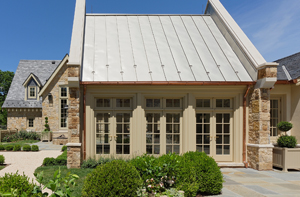7 Must-Do Steps to Get Your Home Ready for Winter
 Did you know the first freeze typically occurs in October in the Washington, DC area? With that in mind, despite the recent mild temperatures, now is the time to start planning for the winter ahead. Exterior home preparation is critical to helping your home weather the harsh winter elements and avoiding damage. Consider the following steps to get your home ready for winter.
Did you know the first freeze typically occurs in October in the Washington, DC area? With that in mind, despite the recent mild temperatures, now is the time to start planning for the winter ahead. Exterior home preparation is critical to helping your home weather the harsh winter elements and avoiding damage. Consider the following steps to get your home ready for winter.
Shut Off Your Hose Bibs
Hose bibs are the water faucets to which your gardening hoses attach. Every year basements become flooded because water is allowed to remain inside the pipes through the freezing winter months, which can cause pipes to burst. When spring rolls around, these broken pipes thaw and begin to leak. If not identified right away, this can lead to extensive water damage. All hose bibs, including those that are “Frost Free,” should be shut off and drained before the winter months to prevent this from happening. Also, don’t forget to disconnect hoses so the faucets can fully drain.
Clean Your Gutters and Downspouts
Depending on the amount of trees around the home, gutters should be cleaned four or more times per year and definitely before winter snows begin. When cleaning the gutters, it is important to also test downspouts to ensure they are not blocked at or near the bottom. When gutters or downspouts are blocked, water backs up and leaks over the front and the back of the gutter, potentially allowing water to get into your home or causing damage to the exterior. Backups can also cause gutters to pull away from the house due to the weight burden of the standing water, so an ounce of prevention goes a long way in avoiding hassles and costly repairs. When cleaning gutters, it is also a good time to clear debris from valleys and low-pitched roofs.
 Ensure Underground Drainage is Cleared
Ensure Underground Drainage is Cleared
Many people have a drain at the bottom of an exterior stairwell and/or underground drains connected to downspouts that take water away from their house. Properly maintaining these drains is as important as keeping your gutters and downspouts clean. In heavy rains or snowfall, floor and grate drains can get clogged with debris, allowing water to build up and get into the house below an exterior door. A blocked underground drain can cause gutters to back up and overflow much like if a downspout is clogged. Keeping these free and clear will minimize the risk of unwanted water infiltration.
Inspect the Exterior Grade
Along with gutters, downspouts and drains, the grading around the exterior of the home plays a critical role in keeping water and excess moisture away from the structure. Because of that, it is recommended that you inspect the exterior of the home twice per year to ensure a sloped grade away from the house. When dirt is disturbed during construction or landscaping it often settles in odd ways. Add dirt to settled areas and clean out excess mulch to allow an easy flow of water away from the house.
Update Your Snow Guards
Snow sliding off your roof can cause costly damage to your home and is a liability. Snow guards prevent these slides and can help protect your family and visitors from dangerous accidents. If you currently have snow guards, it’s imperative to have them inspected as heavy snows from previous blizzards may have damaged them. At a minimum, perform your own visual inspection to make sure your snow guards and the surrounding roof materials are in good condition. If you need repairs, there is any question, or you don’t have guards already, seek an experienced roofer to assist before the snow arrives.
Have your Fireplace & Chimney Inspected
 Whether you have a gas or wood-burning fireplace, a regular schedule of service and maintenance is highly recommended. Wood-burning fireplace flues should be cleaned at least once every two years – more depending on usage – to remove the buildup of creosote, which is a normal byproduct of wood fires. With gas fireplaces, a technician should inspect the operation of the pilot flame or electronic igniter, the valve pressure, the heat-exchange area, the log positioning and the overall tightness of the electrical connections to ensure optimal performance and safety. Also, all fireplaces should have an annual chimney inspection. A thorough inspector will review the condition of the caps and mesh, crown, flashing, bricks and masonry, liners and ducts. Cracks or other damage to any of these elements should be repaired to avoid water damage. Also, check for any overhanging branches, which should be cut back 10 feet from the chimney opening to prevent them from catching fire or obstructing smoke flow.
Whether you have a gas or wood-burning fireplace, a regular schedule of service and maintenance is highly recommended. Wood-burning fireplace flues should be cleaned at least once every two years – more depending on usage – to remove the buildup of creosote, which is a normal byproduct of wood fires. With gas fireplaces, a technician should inspect the operation of the pilot flame or electronic igniter, the valve pressure, the heat-exchange area, the log positioning and the overall tightness of the electrical connections to ensure optimal performance and safety. Also, all fireplaces should have an annual chimney inspection. A thorough inspector will review the condition of the caps and mesh, crown, flashing, bricks and masonry, liners and ducts. Cracks or other damage to any of these elements should be repaired to avoid water damage. Also, check for any overhanging branches, which should be cut back 10 feet from the chimney opening to prevent them from catching fire or obstructing smoke flow.
Replenish Necessary Winter Supplies
Now is the time to make sure you have the outdoor supplies you’ll need when…and if….snow hits! Snow shovels and something to treat icy patches should be at the top of this list. If you’re still using that cheap, straight shovel you had to settle for during a previous year’s run on shovels, consider purchasing a more ergonomic style while the shelves are still stocked. (Did you know that, on average, more than 11,000 people are injured while snow shoveling each year?) Also be sure to stock up on sand, kitty litter (the old fashioned, non-clumping kind) or a deicer to treat your driveway, steps and walkways as needed. Sand and kitty litter are greener options that won’t harm your concrete, lawn or pets, but they do tend to be messier. If you opt to go the deicer route, BOWA’s experts recommend either calcium chloride or magnesium chloride, which aren’t as corrosive as sodium chloride (rock salt). Keep in mind, with new concrete you should avoid using all deicers in the first year.
By accomplishing these simple tasks early, you can enjoy the months ahead snuggled by a cozy fire knowing your home is ready for winter. If you have any questions on exterior home maintenance, let us know. We’re always happy to help.
OTHER POSTS
